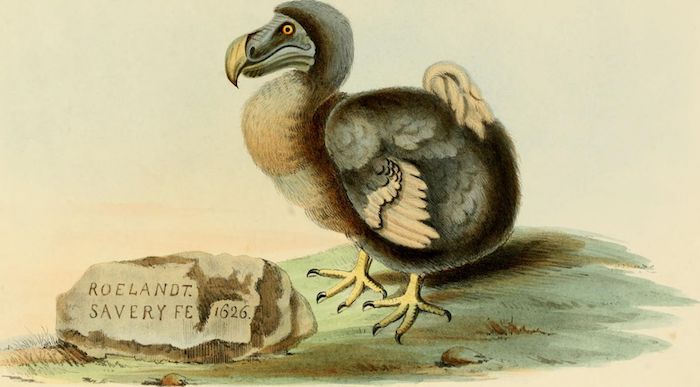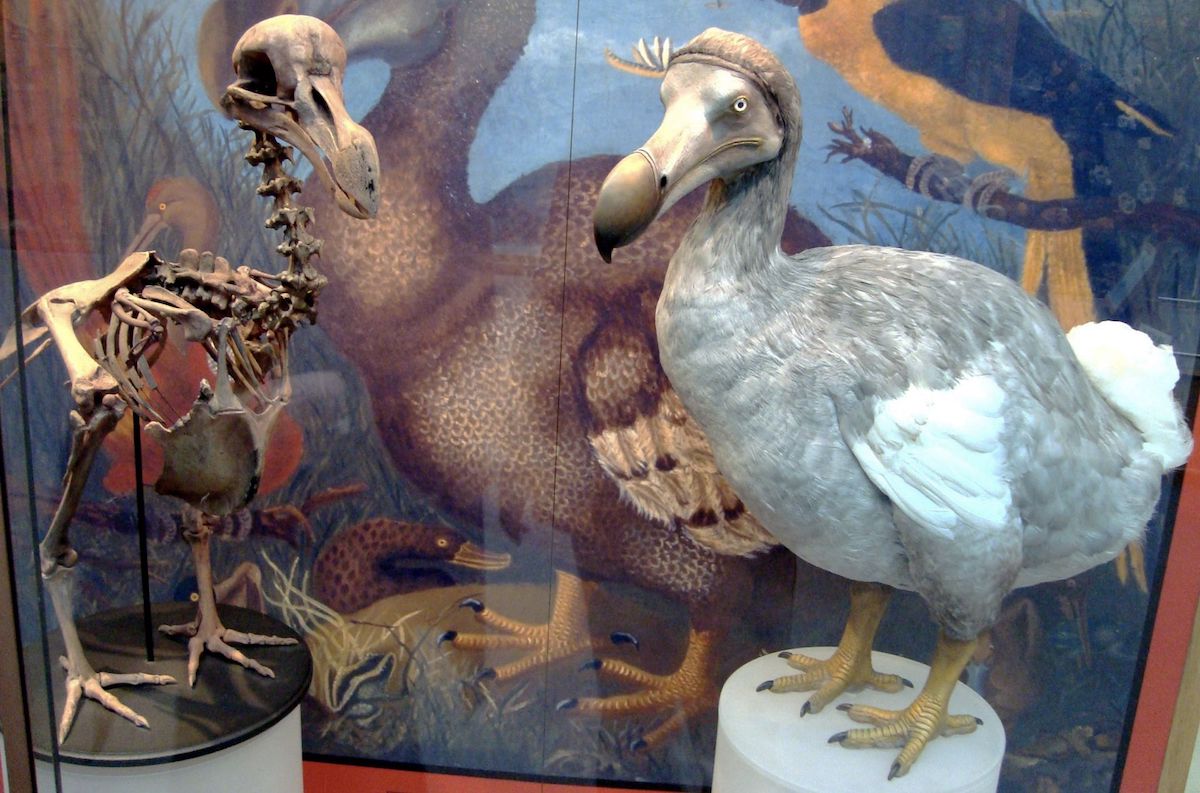Dodo
 Wild species with small ranges often disappeared after--and because--they encountered Europeans. Eighteenth-century examples include the Steller’s sea cow of the North Pacific (a much larger relative of the manatee, several species of which still exist, all classified “Vulnerable” by the International Union for Conservation of Nature) and the blue buck, an antelope native to southern Africa. The most famous such casualty was the dodo of Mauritius, which survived less than a century after being noticed by Dutch sailors in 1598. As was the case with the moas in New Zealand, naïve and flightless birds proved easy prey for human hunters, and for introduced predators like cats and dogs, which, along with pigs and rats, ate eggs and destroyed nests. The solitaire (Pezophaps solitaria), the dodo’s only close taxonomic relative (both were unusually large members of the pigeon family), and indigenous to the nearby island of Rodrigues, met a similar fate in the eighteenth century.
Wild species with small ranges often disappeared after--and because--they encountered Europeans. Eighteenth-century examples include the Steller’s sea cow of the North Pacific (a much larger relative of the manatee, several species of which still exist, all classified “Vulnerable” by the International Union for Conservation of Nature) and the blue buck, an antelope native to southern Africa. The most famous such casualty was the dodo of Mauritius, which survived less than a century after being noticed by Dutch sailors in 1598. As was the case with the moas in New Zealand, naïve and flightless birds proved easy prey for human hunters, and for introduced predators like cats and dogs, which, along with pigs and rats, ate eggs and destroyed nests. The solitaire (Pezophaps solitaria), the dodo’s only close taxonomic relative (both were unusually large members of the pigeon family), and indigenous to the nearby island of Rodrigues, met a similar fate in the eighteenth century.

In 1848, the naturalist Hugh Strickland published the first comprehensive study of both species in English, entitled The Dodo and Its Kindred. His introduction gives a sense of the conventional understanding of extinction at that point. He first noted that “It appears…highly probable that Death is a law of Nature in the Species as well as in the Individual; but this internal tendency to extinction is in both cases liable to be anticipated by violent or accidental causes,” before attributing the disappearance of both species to what he identified as a novel cause: “the agency of Man.” He went on to lament that after being “speedily exterminated,” so little evidence of them remained that although the birds were “almost contemporaries of our great-grandfathers” they “became associated in the minds of many persons with the Griffin and the Phoenix of mythological antiquity.”  Of course this scarcity of evidence also accounts for the plump dodo drawn by John Tenniel when he illustrated Alice in Wonderland (and the image of a similarly hypertrophied bird serves as Strickland’s frontispiece). Tenniel based his dodo on a painting at the Oxford Museum of Natural History, which also holds the only surviving remains of dodo soft tissue. Recent research has suggested that dodos were actually not so portly, and the museum’s dodo display has been revised to feature a relatively streamlined configuration.
Of course this scarcity of evidence also accounts for the plump dodo drawn by John Tenniel when he illustrated Alice in Wonderland (and the image of a similarly hypertrophied bird serves as Strickland’s frontispiece). Tenniel based his dodo on a painting at the Oxford Museum of Natural History, which also holds the only surviving remains of dodo soft tissue. Recent research has suggested that dodos were actually not so portly, and the museum’s dodo display has been revised to feature a relatively streamlined configuration.
Although he regretted the disappearance of “any race of organic beings, whose progenitors colonized the pre-adamite Earth,” Strickland consoled himself by reflecting on the divinely ordained dominion of Man and the inevitable march of civilization. It was, therefore, he concluded, “the duty of the naturalist to preserve…the knowledge of these extinct or expiring organisms, when he is unable to preserve their lives.” Like most early commentators on similarly limited extinctions (as well as some later ones), he did not criticize the agents of extermination.

| « American Bison | Thylacine » |
